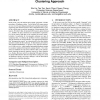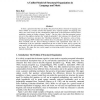954 search results - page 2 / 191 » Principles and Models for Organizing the IT Function |
BMCBI
2006
13 years 7 months ago
2006
Background: Understanding the relationship between gene expression changes, enzyme activity shifts, and the corresponding physiological adaptive response of organisms to environme...
CIKM
2004
Springer
14 years 28 days ago
2004
Springer
In the recent years, the Web has been rapidly “deepened” with the prevalence of databases online. On this deep Web, many sources are structured by providing structured query i...
JAIR
2002
13 years 7 months ago
2002
Is there a general model that can predict the perceived phrase structure in language and music? While it is usually assumed that humans have separate faculties for language and mu...
WICSA
2008
13 years 9 months ago
2008
An organization is architecturally competent if it has the ability to acquire, use and sustain the skills and knowledge necessary to carry out architecture-related practices that ...
ASIACRYPT
2005
Springer
14 years 1 months ago
2005
Springer
Abstract. This paper reconsiders the established Merkle-Damg˚ard design principle for iterated hash functions. The internal state size w of an iterated n-bit hash function is trea...


